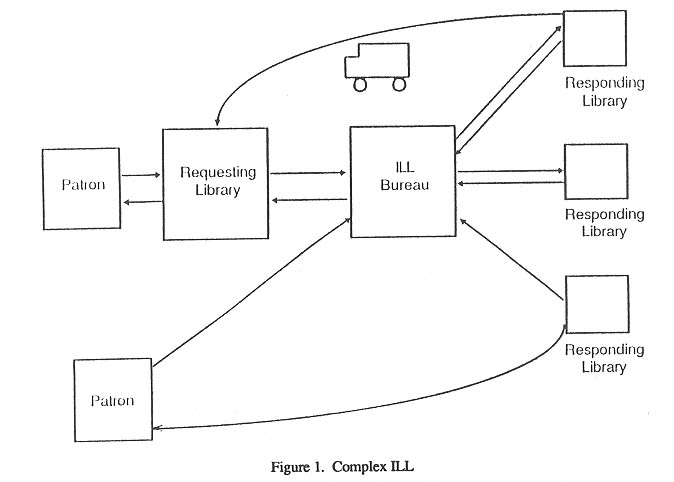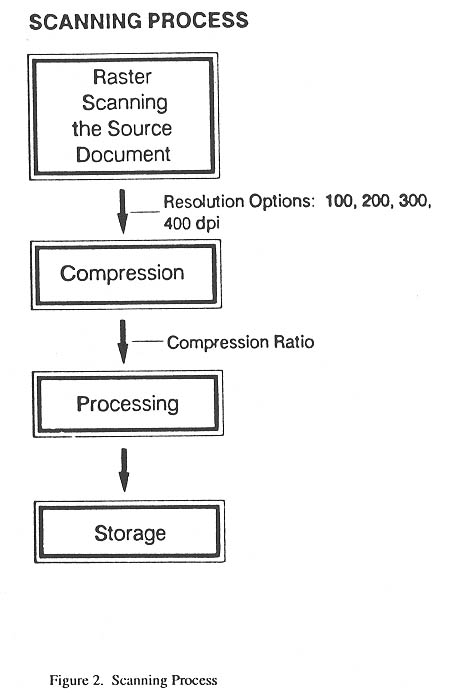
Mounir A. Khalil
Science Library
City College of CUNY
New York, NY 10031, USA
E-mail: moucc@cunyvm.ccny.edu
Abstract: This paper describes the application
of the optical technology for developing a local journal article database
for electronic paperless document delivery service. The system provides
instant access to requested articles. Includes price lists of hardware/
software needed for the database.
In the last two decades, we have seen important changes in the way we use information. Microcomputers have become indispensable tools in our daily life. Of most importance is the dramatic decrease in computer hardware costs and increase in computer hardware power. Nowa-days microcomputers have speeds and memory capacities comparable to the most powerful mini-computers a few years ago. There is increasing use of small computer systems, such as per-sonal computers and Unix-based multiuser workstations. Individual users of computer systems do not work in isolation and want to access data from several sources in preparation of a document. Use of telecommunications using networking is the compelling factor for interconnection among all these small systems. In addition, digital optical technology has made it possible to use optical disks for storing huge amount of data. For example, 12-inch disks can store up to 9-GB of data (Wust, 1991), enough to store the contents of 150,000 pages. Stored data on optical disks can be easily replicated back to paper. The technological problems will soon disappear. What remains is how to plan and design an efficient system and educate the users about the power and potential of this new technology.
Information technology has enhanced many aspects of daily library operations by automating the organization, storage , and retrieval of information. Technologies such as public access catalo-gues and online databases have expanded access to bibliographic information, providing faster and more efficient access to wider materials. However, despite the ease with which bibliographic references are found, users often experience long delays in receiving the original document for the following reasons:
• The application of information technology is primarily to the retrieval of bibliographic infor-mation, rather than the physical delivery of actual documents to end-users. The discrepancy between bibliographic access and document supply threatens to become even more acute as a result of the increase in bibliographic access engendered by recent developments of end-user searching of locally mounted citation database, CD-ROMs, and network-accessible library catalogues (Swain & Cleveland, 1992).
Integrated local journal article database system will form a crucial part of the electronic libraries that have been envisioned for development on the research computer networks that link academic and research libraries throughout the world. In America, President Clinton has the NREN initiative to create information networks capable of providing easy access to vast information resources including full text.
2. WHY IS IT NECESSARY FOR LIBRARIES TO HAVE SUCH A LOCAL JOURNAL DATABASE?
Over the last few years , substantial increases in the cost of serial publications have forced libraries to cancel subscriptions to journal in many disciplines. At the same time, scholars have been demanding greater access to more publications. As mentioned previously, the developing of a local journal database using, preferably an optical disk over other disks, it will make it easy for the faculty and students as well as any users to search the citation in the database and retrieve a copy of full-text from the system. Copyright fee could be paid either by the library or user. The library could fax the copy of the article or send it electronically to their home/office computers.
While economic pressures may cause libraries to cancel journal subscriptions, the existence of such a system will make it partially compensate for those cancellations. Such a developed integrated system will fill the gap. Libraries have been trying to supplement their collections with compact disks containing indexes and abstracts from selected journals. With a CD-Index, users find more and more items they want, and it is more and more of what they do not have in their libraries. The development of such a local journal database system including journal articles of the highest demand for document delivery will benefit the users.
Traditionally, an ILL Division receives an ILL request
and tries to locate the journal if the library subscribes to it, where
it shelved and whether the item is immediately available. When the journal
issue is found it has to be physically, retrieved from the shelf and taken
to the photocopier in order to make a copy and send it by fax or mail.
This is time-consuming (Figure 1).

3. ADVANTAGES
Using the optical storage technology to store large numbers of digitized journal articles received from different resources and stored in a local database which could be integrated in other library database would make it easy for faculty and students to use without knowing the various steps of interfaces, search conventions or database formats. In addition, it will improve the library services by using the new technologies. The advantages are as follows:
• Instant availability of the full-text of the requested article 24 hours a day, 7 days a week.
• Quick full-text search which eliminates hours of library research through library indexes and shelves.
• Retrieving documents by a number of users with access to the data communications network.
• No storage or maintenance. For example, a jukebox-like system typically can hold papers that would occupy more than one thousand four-drawer file cabinets.
• Gaining better understanding of how faculty and students use full-text database and how much use is made of online as to printing copies of journal articles locally.
• If the library uses electronic journals, it can be integrated into the system.
• Reducing the duplication of extensive library material among other libraries in the same subject areas.
• Enhancements of resource sharings among libraries which will strengthen the academic program as better library services are developed.
• Free viewing of the image of the journal article
Nowadays image databases use optical disk storage capabilities preferably over other storage media. Optical disk technology provides a sensible solution not only to modernize document delivery but to transform it into an electronic paperless document delivery services. Users can retrieve their articles from their own computers in any place of the world over telephone line using a modem or network such as Internet. Some document delivery vendors such as ADONIS, UMI, etc., and universities such as Carnegie Mellon University, The University of Michigan and Cornell University, are a few examples of libraries which use this technology in document delivery.
How is an image database different from full-text? An image is an electronic photograph of each page composed of black and white dots. It contains all text, graphics, halftones and font data of the original page exactly as published. Each page of the complete article can be stored on CD-ROM or WORM disk (WILLIS, 1992).
When the image is scanned by the scanner it produces the black and white dot composition of the page (300 dpi). Those dots are compressed (CCITT Group 4) and stored on CD-ROM. The process then is reversed when an image is retrieved from the disk for display or printing.
It is actually less expensive to store high quality page images on CD-ROM than storing text only pages in ASCII format on a hard disk of a computer. For example, a typical image page requires 100 KBs of storage space, while that same page in ASCII text is only 3 KBs. This means that ASCII has a 20 to 1 advantage in space over image. The cost differential favors CD-ROM because a hard disk costs 400 times more than CD-ROM storage. A hard disk comes in at about $6 or $10 per MB, while CD-ROM is about $0.02 per MB. So storing the page image on CD-ROM is considerably less costly than storing the same page in a character code format on magnetic disk.
Libraries should consider the use of the cost-effective
optical media to store journal articles.
5. THE MAKING OF DIGITAL IMAGING SYSTEM
Greco (1992) states how a digital journal imaging system is created:
• The image is stored on an optical disk.
• Application software and the stored index information reside in the computer database in order to manage the stored data.
• Document sharing takes place over a computer network such as LAN, WAN, using a image-capable workstation, reducing the need to generate paper copies.

6. TECHNICAL REQUIREMENTS: HARDWARE &
SOFTWARE
As stated earlier, with today's advanced personal computers, a typical configuration will consist of a powerful PC with extended/expanded memory, a CD-Drive and a laser printer. There are many vendors in the market place who can provide systems tailored to any library's budget or special need (Stern, 1990). Many reference sources such as Waegemann's Handbook of Optical Memory Systems provides up-dated information on vendors, consultants for business, government, banks, insurance,....etc. (Waegemann, 91).
Dr. Jeffrey W. Schram, President of Facstore, Inc., New Jersey has provided the following information on a sample system configuration, as well as the cost of the needed hardware and software. Librarians can save some money by using their existing microcomputers, laser printers and Novell networks. However, they do need to buy scanner, imaging software, OCR software and fax card, if there do not have these now:
PC 486 Less than $ 2,000
Scanner with automatic feed $ 2,000
Laser Printer $ 1,800
10 User Novell network $ 2,000
Novell server with 2 gigabytes $ 8,000
Imaging software and OCR $17,000
Faxing capabilities with hardware and software $ 2,500
Installation fee for 10 user Novell Network $ 400
Total $35,300
Plus training fees ?
For larger libraries, A UNIX-based SUN station is recommended . The system will have the following configuration:
25 page per minute scanner with automatic feed $12,000
If the system uses PC's Additional PC's
should be purchased to act as X Windows servers. $ 9,000 @
UNIX software for OCR of images and full text search $39,000
7. CONCLUSION
Retrieving journal articles from local image database can be done within minutes. Viewing an article from such retrieval is free unless the user has to pay for the printing. With this type of system, the distributed model of client and server will provide the greatest leverage for wide use of image databases. This will also make the faxing or sending an article over Internet much easier. The technology is here today to provide researchers, library users and librarians the opportunity to have articles faxed to them in their workplace. It is widely accepted that it would be a tremendous substitute to the currently extensive ILL system for obtaining needed material.
This local journal database should be concentrated
on journal articles in high-demand subject areas, so that the needs of
the students and faculty can be met.
REFERENCES
Greco, E.J., "Hybrid strategy guarantees future document access," International Journal of Micrographics and Optical Technology, 10 (2): 51-54, 1992.
Lynch, Clifford, "Electronic imaging in the university environment: issues and applications," in Proceedings of the International Electronic Imaging Exposition & Conference, Mass, 1988. pp. 596-601.
Stern, Barrie and Campier, H., "ADONIS- Document delivery in the CD-ROM age," Interlending and Document Supply, 18 (3): 79-85 (1990).
Swain, Leigh and Cleveland, Gary "Electronic document delivery and libraries," INSPEL, 26 (2): 169-184, 1992.
Thomas, George and Walker, Frank L. "A Prototype electronic document delivery system," in Proceedings of the 53rd ASIS Annual Meeting, 1990. pp. 29-38.
Waegemann, C. Peter. The Handbook of optical Memory Systems. Boston, MA: Optical Disk Institute, 1991.
Walker, Frank and Thomas, George, "A Hybrid system for retrieval of online biomedical citations and optical disk-based documents," in Proceedings of Optical Publishing & Storage, 1987. pp. 179-191.
Willis, Don, "Imaging: The information access tool of the nineties," in Proceedings of the Thirteenth National Online Meeting, New York, May 1992. pp. 435-444.
Wust, Ruth, "Optical disk based document delivery
at the Congressional Research Service of the Library of Congress," in Proceedings
of the International Essen Symposium, Essen 1991. Essen, Germany, University
of Essen Library, 1991. pp. 169-177.